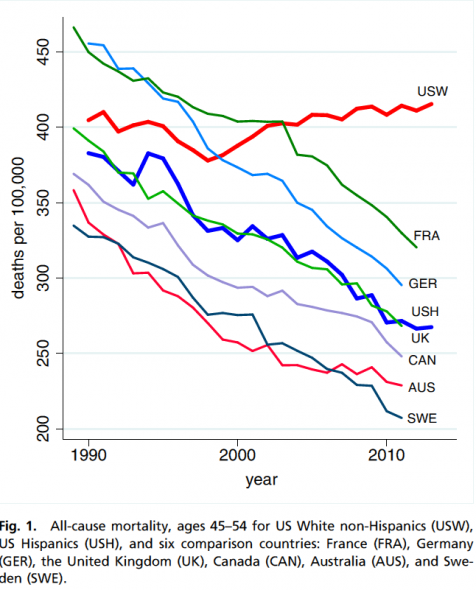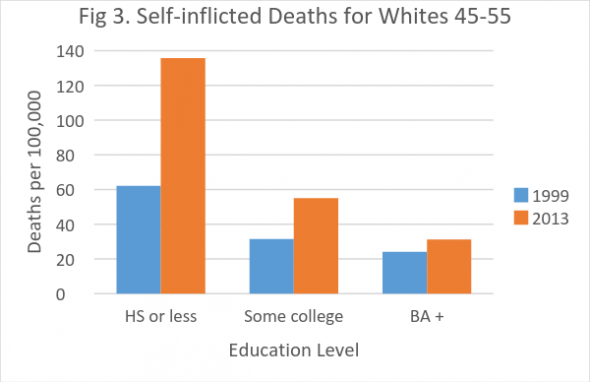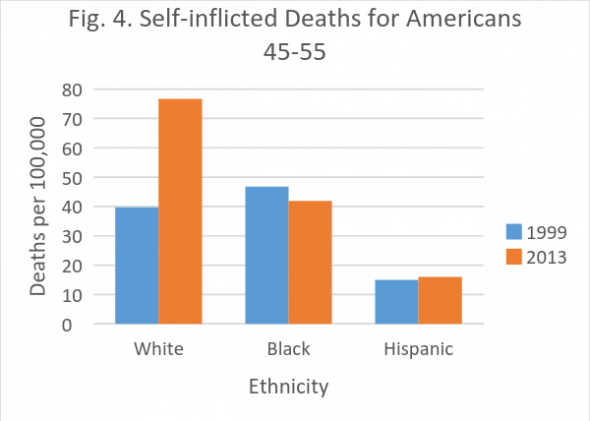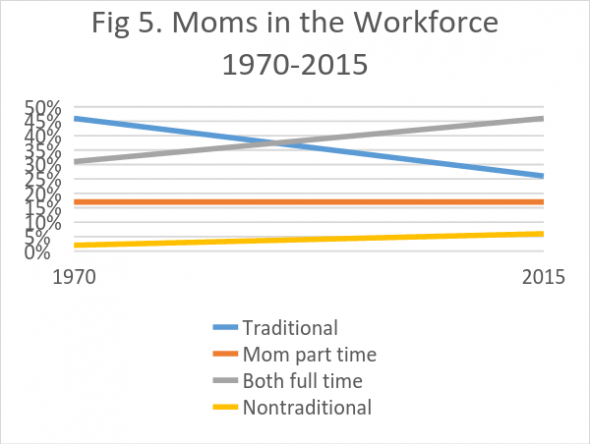Why Mortality is Rising for Middle Aged Whites
Since 2000, the death rate for this group has begun rising. Are there political causes?
Is it a coincidence that deaths are increasing among the demographic that is most supportive of Donald Trump—people who are white, middle aged, and have less than a college education? This is also the demographic that in recent years has increasingly defected from the Democratic Party, but has been largely ignored by those planning social policy.
Over the past few decades death rates have been declining among most groups in the United States and other wealthy countries. This decline has been driven by better prevention and health care, as well as by behavioral changes such as a reduction in smoking. However, recently middle-aged white Americans have been an exception to this trend.
A new paper by the Princeton economists Anne Case and Angus Deaton reports that mortality rates have increased among white middle-aged (45-55) white Americans in recent years, at a time when they have been shrinking for other groups.
Figure 1, taken from the paper, shows the death rate for middle-aged white non-Hispanic Americans between 1990 and 2013. Around the start of the new century, it reversed direction and started rising.
This trend is not seen in other rich countries including France, Germany, the United Kingdom, Canada, Australia, or Sweden. Nor is it found among Hispanic Americans or black Americans (not shown on the chart but dropping from 797 to 582, still very high but moving in the right direction).
Case and Deaton find the increased death rate is largely self-inflicted. It is driven by increased drug and alcohol poisonings, suicide, chronic liver diseases and cirrhosis. Figure 2, also taken from their report, shows the increase in death rates from these three causes. During this period, by comparison, deaths from lung cancer have dropped and those from diabetes have stayed about the same despite the obesity epidemic.
Figure 3 shows that people with less education are far more at risk of dying from suicide, alcohol and drug poisoning, and liver diseases (presumably reflecting excessive drinking) than those with more education. The gap between those whose education stopped at high school and those with a college degree has widened substantially over time, from a ratio of 2.6 in 1999 to 4.3 in 2013.
The rate of death from suicide, alcohol and drug poisoning, and liver disease among middle aged white Americans now far exceeds that among middle aged blacks and Hispanic Americans, as shown in Figure 4.
A scatter plot included in the paper shows steady increases in deaths from both poisoning and suicides in all regions of the US, although somewhat less in the East and Midwest than in the South and West. The authors also include the results from health surveys that show whites in this age group describe their health less positively recently than they did in the late 1990s.
What has caused this change? The truth is that no one knows the answer. Much of the immediate reaction to the Case and Deaton report speculated about the use of opioid pain killers, which in turn can lead to heroin use.
More drinking, drugs, and suicides are a symptom of stress and unhappiness. Several commentators on the study compared the findings to Russia where excessive drinking increased following the collapse of the Soviet Union, reflecting the uncertainty and financial distress of the times.
A second recent report, from the Pew Research Center, throws light on one source of stress. It describes the pressures on families with minor children where both spouses work. As the next plot shows, the proportion of families where both spouses work full-time has displaced the traditional model in which the husband works full-time and the wife runs the household as the most common family pattern. (The obverse where the wife is the full-time worker—what I call “nontraditional” in Figure 5—has grown but still only represents 6 percent of the households.)
The rise of the two-career family can be regarded as progress to the extent that it reflects growing opportunities for women. But for many families—particularly those with less education—the motivation is likely less an interesting job than financial necessity. The one-job family is increasingly an unaffordable luxury for many.
Pew finds that more than half of all working parents say the act of balancing work and family is difficult. Many report that being a parent has made it harder for them to advance in their career.
The Case and Deaton study raises more questions than answers. What is causing the growing self-inflicted death rates among middle-aged whites? Can anything be done about it? Should we drop the emphasis on race and ethnicity and concentrate on people in need, whatever their race?
The increasing death rate among middle-aged white Americans with relativity little education suggests a deep despair in that demographic, sufficient to have changed the trend of white American mortality from decreasing to increasing.
Changes in the economy are no doubt prime drivers of this rising death rate. In Wisconsin, Madison enjoys much the strongest economy. Yet even there, jobs for people without college degrees are disappearing, as most recently reflected in Oscar Meyer’s recent announcement that it would close, even as high tech companies like Epic Systems continue to grow.
This raises the question as to why African Americans are not showing the same self-destructive reaction to distress; if anything, they have been even more affected by the deindustrialization of the American economy than the white working class. Changes in the economy have not been good for people with limited education, whatever their race. So why haven’t black rates of suicide and death from drugs and alcohol grown along with whites? Perhaps one factor is the greater expectations of whites. The world they knew is going away and they feel forgotten. For black Americans, the past may seem less like a lost utopia.
Another possible source of pessimism could be the widespread myth that Social Security and Medicare are going bankrupt and will not be there for them when they reach retirement age. Typically, proposals to turn these programs into state block grants exempt present recipients and those within 10 years of qualifying. This means that people who are between 45 and 55 today will be the first to be affected if one of these proposals is adopted.
Could support for Trump be another a manifestation of this frustration? His support is strongest among middle-aged white voters without college degrees. He promises to fence out immigrants. He plays up his independence from wealthy donors, promising in his tweets to make hedge fund managers pay more taxes, though his tax plan does not do this.
Too often proposals to help people impacted by economic changes are described as targeted at minorities, either by their proponents or opponents. Yet it clear that a significant number of white Americans are also under stress and would benefit by, for example, a serious program to rebuild our infrastructure.
Data Wonk
-
Why Absentee Ballot Drop Boxes Are Now Legal
 Jul 17th, 2024 by Bruce Thompson
Jul 17th, 2024 by Bruce Thompson
-
The Imperial Legislature Is Shot Down
 Jul 10th, 2024 by Bruce Thompson
Jul 10th, 2024 by Bruce Thompson
-
Counting the Lies By Trump
 Jul 3rd, 2024 by Bruce Thompson
Jul 3rd, 2024 by Bruce Thompson


























Great article. Being a worker in America used to come with the expectation of becoming middle class. It’s a rude awakening to find downward wage pressure due to offshoring and plentiful immigration from Third World countries means you get to join the Third World economy in your middle age. Combine that with the traditional male value that successful men work hard to support their family and suddenly there’s no ground beneath your feet. Also, male dominated industries got slammed in the Great Recession and hardly recovered. Meanwhile health care and education female-dominated industries that are harder to offshore, have done well. What do you about this group? They’re not legally a disadvantaged group. They’re white! They’re male! Makes one ponder what it means to be disadvantaged, or at least who looks after the people who traditionally looked after themselves.
Thanks again for one of your detailed data reports on the topic of white males increasing death rates through self inflicted methods. I am well past this age block and retired from the workforce. We can all speculate. We do not that quality labor opportunities with better wages has been shrinking for decades. Lack of education also will diminish opportunities and doors that typically open along a work career. In my peer group coming out in the 60s, a high school man could jump right into a middle class unskilled labor job right out of school. That is a rare exception today.
The many factories that supported this labor class are gone. I watched them disappear along my bus and drive route of 6th and 2nd Street to the downtown area from 1970 to 2010. I also did a research paper from census data over 15 years ago and the Milwaukee Metro area lost about $3 Billion in annual family median income from 1970 to 2000. A similar amount shifted to Waukesha. Wisconsin now leads the states in lost family income since 2000. As a person ages into late 40s and 50s and youth has worn off, a reality of desperation sets in on the fate that awaits, debt load, unrealized and collapsing dreams, will never own a new car, etc. Census data prior to 2000 is in books unless they have been digitized. A detailed analysis to about 1960 could be real helpful back to when jobs were plentiful and life was good for many.
I am Gen X. Age 46. If I hadn’t created myself a family, I’d be gone, now, too. At my own hand. There is nothing here to live for, although the scenery is great.
The social contract was dropped with us Latch Key Kids far before we even got out of High School to be greeted with the certainty of our Elders that we are the scourge of the United States. Of course, we shall take ourselves out early now that it is evident the Great Elders are not retiring and have no more use for us. No one wonders how to attract Generation X, nope. Everyone is wondering how to attract the Millennials…after trying to trash them, too.
So, enjoy the Social Security and the Medicare that will not be available, due to the votes of the elders (and oddly enough people my very own age such as Scott Walker and Paul Ryan), for those of us age 45 and under, y’all. And don’t count on me and people my age to take care of things because we were raised not to stir up the crap on the bottom.
Oh, and out here in this rural area of Wisconsin? The public school sucks, too.
I missed this article when you first published it, and finding it now is a reminder of why I should read you more often. Yesterday Josh Marshall published his take on the original data at Talking Points Memo: http://talkingpointsmemo.com/edblog/you-can-t-understand-american-politics-without-reading-this-study
Perhaps a follow-up is in order.